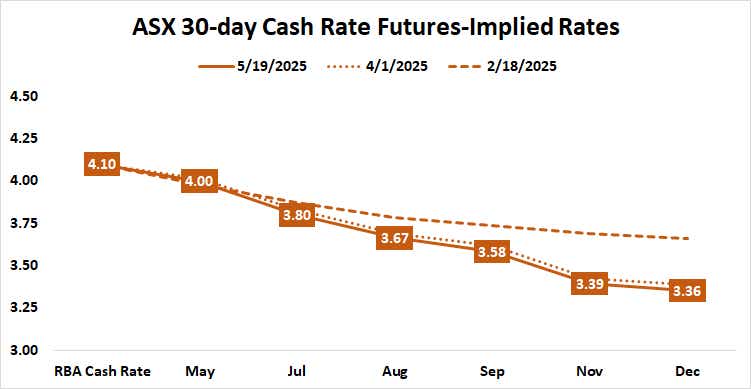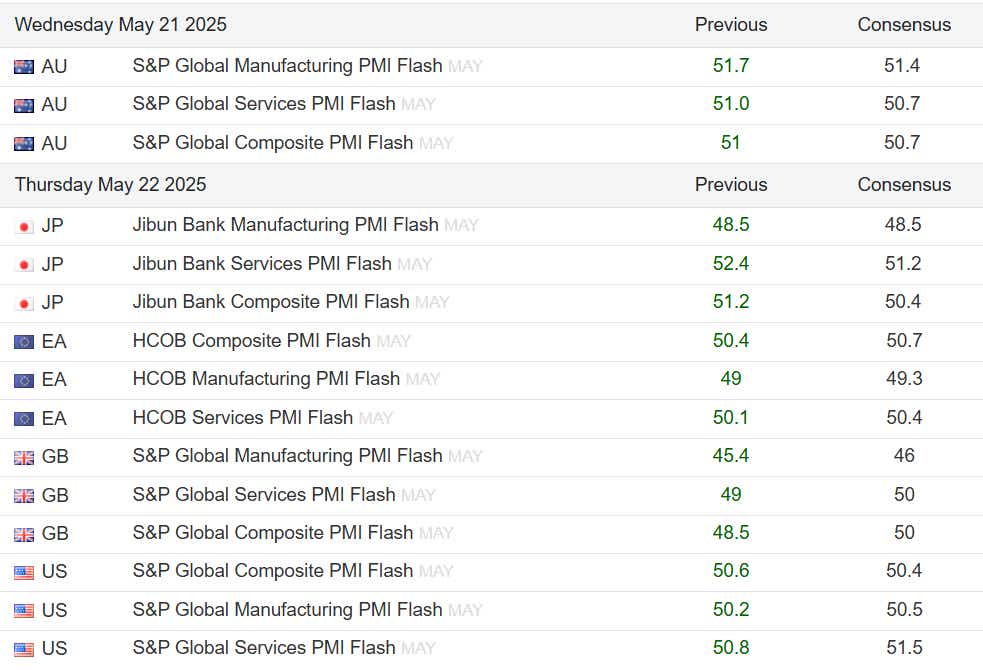RBA Rate Decision, UK CPI, Global PMI Data: Macro Week Ahead

RBA Rate Decision, UK CPI, Global PMI Data: Macro Week Ahead
By:Ilya Spivak
The markets are looking the other way after a U.S. credit downgrade. Can they ignore recession risk?
- Global markets continue to settle, shrugging off US rating downgrade.
- RBA meeting, UK CPI data may flag little scope for more policy support.
- S&P Global PMI data may signal that worldwide recession risk is rising.
Normalization from April’s panic extremes continued to bloom across financial markets last week. Stocks rose, with the S&P 500 and the tech-tilted Nasdaq 100 scoring healthy gains of 5.2% and 6.8% respectively. Treasury bond yields and crude oil prices rose together, making for seemingly pro-growth backdrop. Even the U.S. dollar edged up.
A shock rating downgrade of the United States at Moody’s, the last of the major credit agencies to retain a “Aaa” setting after Standard & Poor’s and Fitch lowered their marks by a step in 2011 and 2023, has done little lasting damage. Markets opened the week in a fragile mood but have since grown placid.
Against this backdrop, here are the key macro waypoints to consider in the days ahead.
Reserve Bank of Australia (RBA) interest rate decision
Australia’s central bank is widely expected to cut its target for the benchmark cash rate by 25 basis points (bps) from 4.1% to 3.85% this week. The move is fully priced into ASX interest rate futures. The markets see 64bps in cuts this year, implying two standard reductions and a 44% probability of a third one. Rates are then expected to hold steady in 2026.
China is Australia’s largest trading partner. Moreover, the export mix is focused on growth-sensitive industrial inputs like iron ore and coal. This gives the RBA a good vantage point on the impact of the US-China trade war as it arrives at the earlier stages of the global supply chain. Traders may be keen to hear what the central bank has to say.

U.K. consumer price index (CPI) data
Inflation is expected to have quickened in the UK last month. The consumer price index (CPI) is penciled in for a rise of 3.3% year-on-year in April, marking the fastest price growth since February 2024. The core CPI measure excluding volatile food and energy prices is seen at 3.7%, the highest in three months.
The markets interpreted the tone at the Bank of England (BOE) as a bit less dovish than anticipated even as the central bank issued a 25bps rate cut earlier this month. The path to ongoing easing has been repriced to a more modest setting. Traders now discount one more cut this year and a hefty 76% probability of a second one.
The amplitude of speculation has significantly narrowed over the past two months, suggesting that BOE policy bets have become relatively well-anchored. At best, warming CPI data may help reinforce as much, implying that the UK central bank might be seen as slow to respond to signs of economic weakness.
.png?format=pjpg&auto=webp&quality=50&width=768&disable=upscale)
S&P Global purchasing managers index (PMI) surveys
A worrying picture of economic growth trends is expected to appear in the May edition of closely watched purchasing managers index (PMI) data from S&P Global. Perhaps most critically, the pace of activity growth in the US and Eurozone – two out of three growth engines powering worldwide demand – is expected near standstill once again.
This seems hardly encouraging after April’s edition of the data suggested that global growth slowed to the weakest in 17 months. Looking through the fog of trade war headlines, the first quarter produced the weakest US consumption growth in almost two years. Last week’s data flow suggested the second quarter is on track for another poor showing.
Taken together with anemic performance in Europe and China stretching back to the middle of last year, this makes for a potent recessionary threat. It remains to be seen whether or not the markets are prepared to consider this broader view now that the next U.S. tariff policy cliffhanger seems some time away.

Ilya Spivak, tastylive head of global macro, has 15 years of experience in trading strategy, and he specializes in identifying thematic moves in currencies, commodities, interest rates and equities. He hosts Macro Money and co-hosts Overtime, Monday-Thursday. @Ilyaspivak
For live daily programming, market news and commentary, visit #tastylive or the YouTube channels tastylive (for options traders), and tastyliveTrending for stocks, futures, forex & macro.
Trade with a better broker, open a tastytrade account today. tastylive, Inc. and tastytrade, Inc. are separate but affiliated companies.
Options involve risk and are not suitable for all investors. Please read Characteristics and Risks of Standardized Options before deciding to invest in options.
tastylive content is created, produced, and provided solely by tastylive, Inc. (“tastylive”) and is for informational and educational purposes only. It is not, nor is it intended to be, trading or investment advice or a recommendation that any security, futures contract, digital asset, other product, transaction, or investment strategy is suitable for any person. Trading securities, futures products, and digital assets involve risk and may result in a loss greater than the original amount invested. tastylive, through its content, financial programming or otherwise, does not provide investment or financial advice or make investment recommendations. Investment information provided may not be appropriate for all investors and is provided without respect to individual investor financial sophistication, financial situation, investing time horizon or risk tolerance. tastylive is not in the business of transacting securities trades, nor does it direct client commodity accounts or give commodity trading advice tailored to any particular client’s situation or investment objectives. Supporting documentation for any claims (including claims made on behalf of options programs), comparisons, statistics, or other technical data, if applicable, will be supplied upon request. tastylive is not a licensed financial adviser, registered investment adviser, or a registered broker-dealer. Options, futures, and futures options are not suitable for all investors. Prior to trading securities, options, futures, or futures options, please read the applicable risk disclosures, including, but not limited to, the Characteristics and Risks of Standardized Options Disclosure and the Futures and Exchange-Traded Options Risk Disclosure found on tastytrade.com/disclosures.
tastytrade, Inc. ("tastytrade”) is a registered broker-dealer and member of FINRA, NFA, and SIPC. tastytrade was previously known as tastyworks, Inc. (“tastyworks”). tastytrade offers self-directed brokerage accounts to its customers. tastytrade does not give financial or trading advice, nor does it make investment recommendations. You alone are responsible for making your investment and trading decisions and for evaluating the merits and risks associated with the use of tastytrade’s systems, services or products. tastytrade is a wholly-owned subsidiary of tastylive, Inc.
tastytrade has entered into a Marketing Agreement with tastylive (“Marketing Agent”) whereby tastytrade pays compensation to Marketing Agent to recommend tastytrade’s brokerage services. The existence of this Marketing Agreement should not be deemed as an endorsement or recommendation of Marketing Agent by tastytrade. tastytrade and Marketing Agent are separate entities with their own products and services. tastylive is the parent company of tastytrade.
tastyfx, LLC (“tastyfx”) is a Commodity Futures Trading Commission (“CFTC”) registered Retail Foreign Exchange Dealer (RFED) and Introducing Broker (IB) and Forex Dealer Member (FDM) of the National Futures Association (“NFA”) (NFA ID 0509630). Leveraged trading in foreign currency or off-exchange products on margin carries significant risk and may not be suitable for all investors. We advise you to carefully consider whether trading is appropriate for you based on your personal circumstances as you may lose more than you invest.
tastycrypto is provided solely by tasty Software Solutions, LLC. tasty Software Solutions, LLC is a separate but affiliate company of tastylive, Inc. Neither tastylive nor any of its affiliates are responsible for the products or services provided by tasty Software Solutions, LLC. Cryptocurrency trading is not suitable for all investors due to the number of risks involved. The value of any cryptocurrency, including digital assets pegged to fiat currency, commodities, or any other asset, may go to zero.
© copyright 2013 - 2025 tastylive, Inc. All Rights Reserved. Applicable portions of the Terms of Use on tastylive.com apply. Reproduction, adaptation, distribution, public display, exhibition for profit, or storage in any electronic storage media in whole or in part is prohibited under penalty of law, provided that you may download tastylive’s podcasts as necessary to view for personal use. tastylive was previously known as tastytrade, Inc. tastylive is a trademark/servicemark owned by tastylive, Inc.